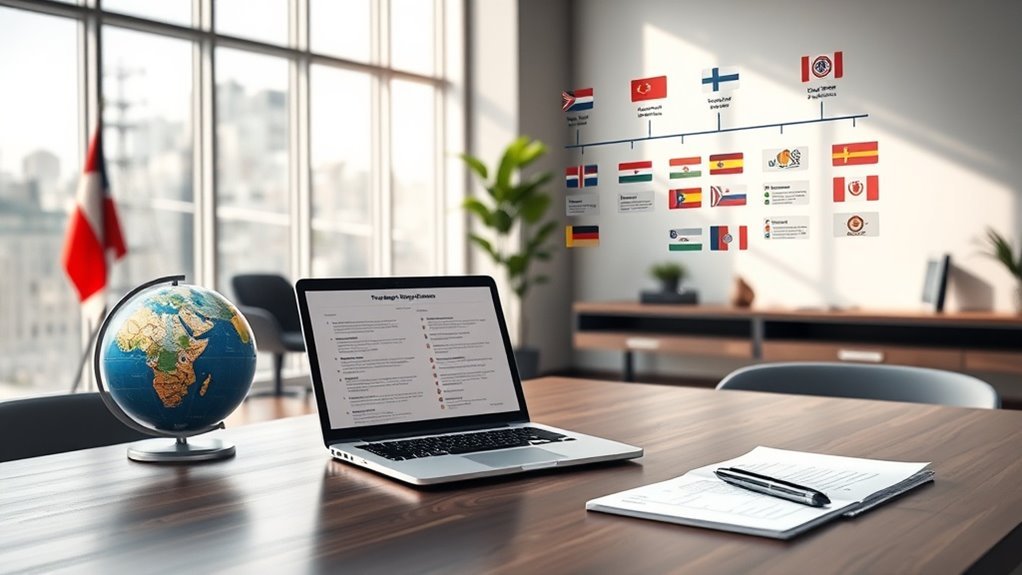International Trademark Registration Through Madrid Protocol
The Madrid Protocol streamlines the process of international trademark registration under Indian laws, enabling you to file a single application for brand protection across multiple countries. By leveraging this treaty, you can efficiently manage your trademark rights, keep track of renewals, and ensure uniformity in your filings. To be eligible, your trademark must adhere to the criteria established under the Trade Marks Act of 1999. Discover the detailed application process and gain insights on how to effectively maintain and enforce your trademark rights on a global scale. Stay tuned for further valuable information.
Key Takeaways
The Madrid Protocol facilitates a streamlined process for businesses seeking trademark protection across multiple countries through a single application. This framework significantly simplifies international trademark registration.
To engage with the Madrid Protocol, applicants must adhere to the provisions set forth in India’s Trade Marks Act of 1999, ensuring that they meet the necessary eligibility criteria for various categories of trademarks.
In India, trademark applications are processed through the Controller General of Patents, Designs and Trademarks (CGPDTM), which then forwards the applications to the World Intellectual Property Organization (WIPO) for further action.
To ensure ongoing trademark protection, renewals must be conducted every ten years. Businesses should maintain diligent oversight of these renewal timelines to protect their trademarks effectively.
Additionally, it is critical for businesses to actively enforce their trademark rights against unauthorized usage. This proactive approach helps in preserving brand identity and integrity in international markets, which is essential for maintaining a competitive edge.
Overview of the Madrid Protocol

The Madrid Protocol is an essential international treaty that streamlines the trademark registration process for businesses looking to protect their brand in multiple countries, including India. Under this treaty, applicants can file a single application to cover various jurisdictions, which eliminates the need to submit separate applications for each individual country. This significantly simplifies the process for Indian businesses seeking to expand their reach in international markets.
By utilizing the Madrid Protocol, businesses can designate the specific countries in which they wish to secure trademark protection. The entire process is overseen by the World Intellectual Property Organization (WIPO) and provides a centralized system, making it easier for Indian companies to manage their trademark rights internationally.
This treaty proves particularly advantageous for Indian businesses aiming for global expansion, as it allows them to track and maintain their trademark rights with greater efficiency.
Key Benefits of Using the Madrid Protocol
When considering international trademark registration under Indian laws, the Madrid Protocol provides substantial benefits.
It facilitates a simplified application process, making it easier to manage your trademark efforts across various countries.
Additionally, the protocol enables Indian brands to protect their identity on a global scale, enhancing their international market presence and safeguarding against infringement.
Simplified Application Process
By utilizing the Madrid Protocol, you can significantly simplify your international trademark registration process in accordance with Indian laws and regulations.
Instead of filing multiple applications in various countries, you can submit a single application that covers multiple territories. This approach not only saves time but also reduces the likelihood of inconsistencies in your filings as per Indian jurisdiction.
Managing your trademark becomes much easier, as you’ll only need to monitor one application and one set of renewal deadlines. Moreover, the protocol allows for straightforward modifications when you wish to expand or alter your registered trademark in different countries.
Cost-Effective Trademark Protection
Implementing the Madrid Protocol simplifies the trademark application process while providing a streamlined solution for trademark protection under Indian laws. By registering your trademark through this system, you can file applications in multiple countries with a single submission, making it efficient for international protection.
The central management of your trademark portfolio allows for easy renewal of registrations, minimizing administrative challenges.
Furthermore, the Madrid Protocol offers a unified process that can enhance the overall management of international trademarks. For those seeking effective trademark protection, the Madrid Protocol presents a practical and efficient option within the framework of Indian regulations. Additionally, it is essential to understand that trademark registration not only safeguards your brand but also helps prevent unauthorized use and potential infringement.
Eligibility Criteria for Trademark Registration

To successfully register your trademark in India, you need to meet specific eligibility criteria as outlined by Indian laws and regulations. This includes understanding the types of marks that qualify under the Trade Marks Act, 1999, the qualifications you must hold as an applicant, and the relevant procedures provided by the Controller General of Patents, Designs, and Trade Marks. Familiarizing yourself with these details can streamline your registration process considerably within the Indian jurisdiction. Additionally, it is essential to be aware of the various fees associated with the trademark application process, as these can significantly impact your overall budget.
Types of Eligible Marks
When it comes to trademark registration in India, understanding the types of eligible marks is crucial for effectively protecting your brand. Various marks can be registered under Indian trademark law, including word marks, which consist of letters, numbers, and combinations thereof.
Additionally, design marks, featuring distinctive logos or symbols, can enhance your brand identity. If your goods or services are associated with a unique sound, sound marks may also qualify for registration.
Trade dress, which encompasses the overall appearance and layout of your product packaging, is another viable option. Furthermore, collective marks and certification marks, which indicate quality or membership within a specific group, are also eligible under Indian trademark laws.
Applicant Qualifications Required
Understanding the qualifications needed to apply for trademark registration in India is essential for anyone looking to protect their brand effectively. To be eligible under the Indian trademark law, you must fulfill certain criteria. Generally, you are eligible if you meet one of the following conditions:
| Criteria | Description |
|---|---|
| Nationality | You’re a citizen of India or a foreign national with a business presence in India. |
| Domicile | Your company’s principal place of business is in India. |
| Establishment | You have a real and effective industrial or commercial establishment in India. |
| Application/Registration | You hold an existing trademark in India or have filed an application for a trademark. |
Being aware of these criteria ensures you can navigate the registration process in India smoothly! Additionally, selecting the appropriate trademark classes is crucial for ensuring thorough protection of your intellectual property.
Countries Under Madrid Protocol
If you’re looking to protect your trademark internationally, it’s crucial to consider the Madrid Protocol within the context of Indian laws and regulations. This treaty enables trademark owners to register their trademarks in multiple countries through a single application, promoting easier international expansion for Indian businesses.
Currently, there are 126 member countries, including major markets such as the United States, Japan, and many European nations.
To participate in the Madrid Protocol, you must have a basic trademark application or registration in India, as it serves as the foundation for your international application. It’s also essential to ensure that your trademark complies with the specific requirements of each designated country, as these can vary widely.
Step-by-Step Application Process

To successfully navigate the international trademark registration process under Indian laws and regulations, you’ll want to follow a series of well-defined steps that confirm your application is both thorough and compliant. Here’s how you can get started:
- Conduct a Trademark Search: Before applying, verify that your trademark isn’t already registered in your desired markets. This step is essential to save you time and prevent potential legal issues in the future.
- Prepare Your Application: Gather necessary documents and information, including your trademark representation, classification of goods/services, and details about the applicant. Ensuring all details are accurate and complete is crucial for a smooth application process.
- File Your Application: Submit your application through the Controller General of Patents, Designs and Trademarks (CGPDTM) in India. The CGPDTM will examine and process your application, which may then be forwarded to the World Intellectual Property Organization (WIPO) if international protection is sought. Additionally, understanding trademark infringement is vital for safeguarding your brand and preventing disputes.
Designating Member Countries
When registering your trademark internationally, it’s important to designate the member countries where you seek protection, particularly under the Madrid Protocol. This protocol allows you to select multiple countries in a single application, significantly streamlining the process.
As you choose these countries, evaluate your target markets and identify jurisdictions where you anticipate growth.
Under Indian law, once you have designated a country, your trademark will be protected according to that nation’s legal framework. It’s essential to note that different countries may have diverse registration processes and timelines, and this can influence your overall strategy.
Therefore, it’s advisable to conduct thorough research on the specific requirements of each member country before submitting your application. Careful planning in this regard can enhance the value of your trademark and help protect your brand across various international markets.
Fees and Costs Associated With Registration
Once you’ve designated the member countries for your trademark registration, understanding the associated procedures becomes essential. These processes can vary significantly based on the countries you’ve chosen and the specifics of your application. Here’s a quick overview:
- Basic Application Process: The initial step involves filing your international application, ensuring that it aligns with the requirements established under Indian law and the respective member countries’ regulations.
- Multiple Class Registration: If you wish to register your trademark across multiple classes of goods or services, be prepared to follow additional procedures and provide the necessary documentation for each classification.
- Country-Specific Regulations: Different countries may have their own individual requirements for trademark registration, so it’s important to familiarize yourself with these regulations to ensure compliance during the application process.
Planning ahead will help you navigate these procedures effectively and maintain a seamless registration process under Indian law.
Maintenance and Renewal of Trademark Protection
Maintaining and renewing your trademark protection in India is crucial for preserving your brand’s identity and rights over time.
It’s important to be aware of renewal deadlines, as trademarks in India typically require renewal every ten years. Failing to renew your trademark can result in the loss of exclusive rights, potentially leading to increased competition and brand confusion.
Be vigilant of renewal deadlines; trademarks in India need renewal every ten years to maintain exclusive rights and brand clarity.
Ensure that you actively monitor your trademark’s status and engage in necessary filings well ahead of renewal deadlines. Additionally, keeping your registration details up to date is essential, particularly if there are changes in ownership or contact information.
Regularly enforcing your trademark rights against any unauthorized use or infringements can further solidify your position and ensure that your brand remains protected within India and globally over the long term. Furthermore, understanding the common reasons for trademark rejection can help you preemptively address potential issues during the renewal process.
Common Challenges in International Registration
International trademark registration can present various challenges for businesses, especially within the context of Indian laws and regulations. Navigating the complexities of different countries’ legal frameworks can be daunting.
Here are three challenges you might encounter specifically related to India:
- Language Barriers: In India, the official language of the Patent Office is English, but many business owners may not be proficient in legal terminology. This can lead to misunderstandings during the application process, potentially affecting the accuracy of the submitted information.
- Cultural Differences: Indian markets may have distinct perceptions of trademarks, which can influence how your brand is perceived locally. It’s essential to understand cultural nuances to ensure your trademark aligns with local sentiments and doesn’t inadvertently offend or confuse consumers.
- Varying Regulatory Practices: While international registration follows certain protocols, India may have specific requirements that differ from other jurisdictions. Staying informed about these regulatory practices is vital for ensuring compliance and achieving successful registration.
Additionally, securing your trademarks early can greatly enhance your brand’s ability to establish brand identity and protect against potential disputes. Being mindful of these challenges can help you prepare effectively and navigate the process of international trademark registration in the Indian context.
Enforcing Your Trademark Rights Globally
Enforcing Your Trademark Rights in India
As you navigate the intricate landscape of global markets, it’s vital to enforce your trademark rights in India to protect your brand‘s identity. Proactive monitoring of potential infringements is key.
Begin by conducting regular searches for unauthorized use of your trademark, both online and offline in the Indian market. If you discover violations, it’s essential to take prompt action; often, a cease-and-desist letter can help resolve the matter without escalating to formal legal proceedings.
Conduct regular searches for unauthorized trademark use; swift action, like a cease-and-desist letter, can often prevent legal escalation.
Be aware that India has its own set of laws and regulations governing trademark enforcement, so understanding the Trademark Act of 1999 and related legal frameworks will be crucial.
Additionally, building relationships with local legal experts who specialize in intellectual property law can provide valuable guidance and support throughout the enforcement process.
Future Trends in International Trademark Law
As Indian businesses increasingly navigate global markets, staying ahead of changes in trademark law becomes imperative. Here are three future trends in the context of Indian laws and regulations that you should watch:
- AI and Trademark Search: The integration of Artificial Intelligence in trademark searches is set to transform the Indian trademark landscape. AI tools can help businesses efficiently identify potential conflicts and avoid disputes, streamlining the registration process in India.
- Expansion of International Treaties: With the growing recognition of the importance of international trademark protections, more countries may join agreements like the Madrid Protocol. This could provide Indian businesses with enhanced opportunities to expand their brand’s protection across borders, facilitating easier trademark registration internationally.
- Increased Focus on Non-Traditional Marks: Indian laws may evolve to better acknowledge non-traditional trademarks, such as scents, sounds, and colors. This shift will provide brands with innovative ways to distinguish themselves in the market and enhance their identity in a competitive environment.
Additionally, understanding trademark protection is crucial for businesses to secure their brands effectively in an increasingly interconnected world. Keeping an eye on these trends will be crucial for navigating the evolving landscape of trademark law in India and beyond.
Questions
How Long Does the Madrid Protocol Application Process Take?
While waiting for the perfect moment to register your trademark, it’s important to note that the Madrid Protocol application process in the Indian context can take approximately 6 to 12 months. This duration may vary depending on the specific countries involved and any complications that may arise during the application process.
Can I Amend My Trademark During the Registration Process?
Yes, you can amend your trademark during the registration process in India. However, it’s important to note that such changes may impact the status of your application. Therefore, it is advisable to consult with a trademark attorney to ensure that your amendments align with your goals and comply with Indian laws and regulations.
What Languages Are Accepted for Filing an Application?
You can file your application in Hindi or English, as these are the officially accepted languages under Indian law. Utilizing languages outside of these may lead to delays in processing or necessitate additional translations, so it is advisable to adhere to the accepted languages for a smoother and more efficient legal process.
Are There Any Specific Goods or Services Excluded From Registration?
Yes, certain goods and services are excluded from registration under Indian law. Trademarks that consist of generic terms, descriptive phrases, or marks that are misleading or contrary to public order or morality cannot be registered. It is essential to consult specific guidelines outlined by the Trade Marks Act, 1999 and other relevant regulations when preparing your application.
How Does Brexit Affect the Madrid Protocol for UK Trademarks?
Brexit’s impact on international trademark registrations, particularly under the Madrid Protocol, has been significant for UK trademarks. Now, UK businesses will need to submit separate applications for trademark protection in the European Union, diverging from the unified framework that was previously available. It’s essential for trademark holders to ensure that their protections are clearly defined and maintained, as navigating this new landscape requires vigilance and adherence to current laws and regulations. This shift highlights the need for Indian businesses engaged with UK trademarks to stay informed and proactive in managing their intellectual property rights.







